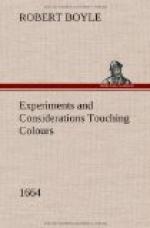[17] Kircher. Art. Mag. lucis & umbrae, lib. 1. part. 3.
In this passage we may take notice of the following Particulars. And first, he calls it a White Mexican Wood, whereas (not to mention that Mornardes informs us that it is brought out of Nova Hispania) the Wood that we have met with in several places, and employ’d as Lignum Nephriticum, was not White, but for the most part of a much Darker Colour, not unlike that of the Sadder Colour’d Wood of Juniper. ’Tis true, that Monardes himself also says, that the Wood is White; and it is affirm’d, that the Wood which is of a Sadder Colour is Adulterated by being Imbu’d with the Tincture of a Vegetable, in whose Decoction it is steep’d. But having purposely enquir’d of the Eminentest of our English Druggists, he peremptorily deny’d it. And indeed, having consider’d some of the fairest Round pieces of this Wood that I could meet with in these Parts, I had Opportunity to take notice that in one or two of them it was the External part of the Wood that was White, and the more Inward part that was of the other Colour, the contrary of which would probably have appear’d, if the Wood had been Adulterated after the afore-mention’d manner. And I have at present by me a piece of such Wood, which for about an Inch next the Bark is White, and then as it were abruptly passes to the above-mention’d Colour, and yet this Wood by the Tincture, it afforded us in Water, appears to have its Colour’d part Genuine enough; for as for the White part, it appears upon tryal of both at once, much less enrich’d with the tingent Property.
Next, whereas our Author tells us, that the Infusion of this Wood expos’d in a Vial to the Light, looks like Spring-water, in which he afterwards adds, that there is no Tincture to be seen in it, our Observation and his agree not, for the Liquor, which opposed to the Darker part of a Room exhibits a Sky-colour, did constantly, when held against the Light, appear Yellowish or Reddish, according as its Tincture was more Dilute




